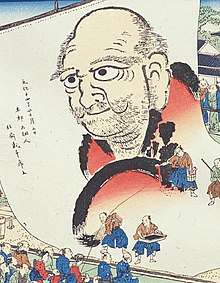Great Daruma
The Great Daruma was a monumental portrait created by Japanese artist Hokusai on 5 October 1817. Also known as the Great Bodhidarma, the work is a depiction of Bodhidharma, known in Japan as Daruma, a revered Buddhist monk of the 5th or 6th century. The original artwork was destroyed in May 1945.
Background
The Great Daruma was not Hokusai's first monumental portrait. In 1804, during a festival at the Gokoku-ji temple in Edo (modern Tokyo), he created a portrait of Daruma said to be 600 feet (180 m) long, using a broom and buckets full of ink.
Conception

Hokusai made the Great Daruma in a courtyard beside the Hongan-ji Nagoya Betsuin Buddhist temple in Nagoya, Japan. The portrait depicted the head of the monk and his upper body swathed in flowing robes. It was drawn on a large expanse of paper, measuring 59 by 35 feet (18 m × 11 m), equivalent to approximately 120 standard tatami mats of 70 by 35 inches (178 cm × 89 cm) each. The eyes were 70 inches (180 cm) wide, the nose 105 inches (270 cm) long, and the mouth 82 inches (210 cm) across.
The event was advertised in advance to draw a large crowd. Hokusai worked for hours adding bold lines of ink until the image was finally revealed when the paper was hoisted into the air using a large wooden beam attached to one end, like a gigantic hanging scroll, or the huge thongdrel thankas of Tibetan Buddhism (usually in silk appliqué).
Reception
As a result of this dramatic feat, Hokusai became known in Nagoya as "Daruma-sen", the Daruma master. The triumph brought greater attention to Hokusai, enabling him to sell more prints to the public, including prints of the Great Daruma. He published a new volume of his Manga sketches in 1817.
Destruction
The original artwork survived in Nagoya until May 1945, when it was destroyed along with the wooden temple building in the bombing of Nagoya in World War II. Contemporaneous promotional handbills survive, with some held at the Nagoya City Museum.
References
- 特別展 北斎だるせん (Special exhibition Hokusai), Nagoya City Museum
- Hanging scroll of Daruma smiling, traditionally attributed to Hokusai, British Museum